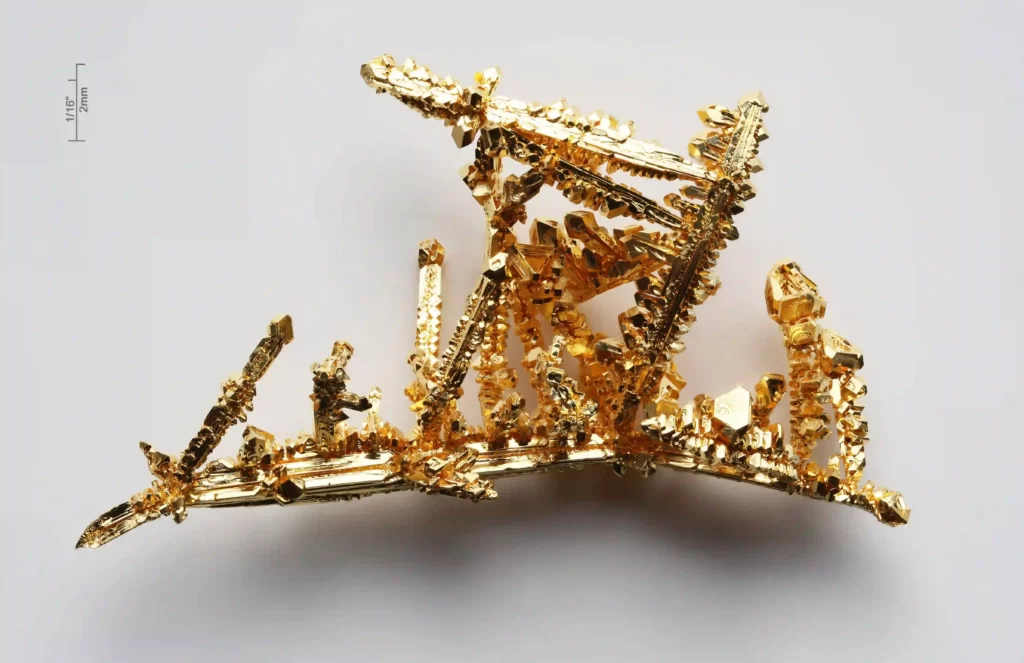Breaking down the science of lab-grown Gold
Gold is a highly valued and sought-after precious metal that has been used for centuries for jewellery, currency, and investment purposes. While gold is typically mined from the earth, researchers have been exploring the possibility of creating gold in a laboratory setting. This process, known as synthetic or lab-grown gold, has the potential to reduce the environmental and social impact of gold mining, as well as provide a new source of this valuable metal. In this blog, we will explore the question of whether gold can be grown in labs and the current state of research in this field.

The Science of Gold Synthesis
The process of creating gold in a laboratory setting is known as gold synthesis or transmutation. This process involves changing the atomic structure of other elements to produce gold atoms. The most common method of gold synthesis involves using nuclear reactors to bombard elements such as mercury, platinum, or bismuth with neutrons. This process can result in the formation of gold atoms, although it is not very efficient and typically requires large amounts of energy.
Another method for gold synthesis involves using chemical reactions to create gold nanoparticles. This process involves reducing gold ions in a solution to create tiny particles of pure gold. While this method is more efficient than nuclear transmutation, it is still not capable of producing large quantities of gold.
Current Methods for Lab-Grown Gold
While scientists have been able to create small amounts of gold in a laboratory setting using nuclear transmutation or chemical reactions, these processes are not yet commercially viable or scalable for large-scale production. However, there is ongoing research and development in this field, and new methods for gold synthesis are being explored.
One promising approach involves using bacteria to create gold nanoparticles. Scientists have discovered that certain strains of bacteria can absorb gold ions from a solution and transform them into pure gold particles. This method is more efficient than chemical reduction and has the potential to be scaled up for industrial production.
Another method involves using lasers to create gold nanoparticles from a solution of gold ions. This process involves using short pulses of laser light to rapidly heat and cool the solution, which causes gold atoms to cluster together and form nanoparticles. This method is also more efficient than chemical reduction and has the potential for large-scale production.
Advantages and Disadvantages of Lab-Grown Gold:
One of the main advantages of lab-grown gold is that it could provide a more sustainable and ethical source of this valuable metal. Gold mining can have significant environmental and social impacts, including habitat destruction, water pollution, and human rights abuses. By producing gold in a laboratory setting, we could potentially reduce these impacts and provide a more responsible source of gold.
Another advantage of lab-grown gold is that it could be more consistent in quality and purity than mined gold. Gold from different mines can vary in purity and composition, which can affect its value and usability. Lab-grown gold, on the other hand, can be precisely controlled and engineered to meet specific requirements.
However, there are also some potential drawbacks to lab-grown gold. One is that it may not have the same cultural or symbolic value as mined gold. Gold has been revered and valued by humans for thousands of years, and its rarity and uniqueness have contributed to its allure. Lab-grown gold, which could potentially be produced in large quantities, may not have the same mystique or appeal as mined gold.
Another potential drawback is the cost. While lab-grown gold has the potential to be more sustainable and ethical, it may also be more expensive to produce than mined gold.
Potential Applications of Lab-Grown Gold
Lab-grown gold has a wide range of potential applications in various industries. One of the most obvious is in the jewellery industry, where lab-grown gold could provide a sustainable and ethical alternative to mined gold. This could be particularly appealing to consumers who are concerned about the environmental and social impact of mining.
Lab-grown gold could also have applications in electronics, where it is used in the production of components such as circuit boards and semiconductors. Gold is an excellent conductor of electricity and is highly resistant to corrosion, making it an ideal material for electronics manufacturing.
Another potential application is in the field of medicine, where gold nanoparticles are used in diagnostic and therapeutic applications. Gold nanoparticles have unique properties that make them ideal for targeted drug delivery and imaging, and lab-grown gold could potentially provide a more consistent and reliable source of these nanoparticles.
The Future of Lab-Grown Gold
While lab-grown gold is not yet commercially viable or widely available, there is ongoing research and development in this field. Scientists are exploring new methods for gold syntheses, such as using bacteria or lasers, and are working to improve the efficiency and scalability of these methods.
The development of lab-grown gold could have significant implications for the gold industry and for society as a whole. It could provide a more sustainable and ethical source of this valuable metal, while also opening up new applications and markets.
Closing Thoughts
While lab-grown gold is not yet a commercially viable or widely available product, there is ongoing research and development in this field. Scientists are exploring new methods for gold synthesis, and the development of lab-grown gold could have significant implications for the gold industry and for society as a whole. While there are potential advantages and disadvantages to lab-grown gold, its potential for sustainability, consistency, and innovation make it an exciting area of research and development.
